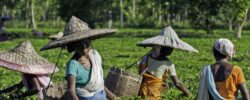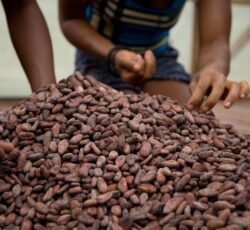6 questions about climate-resilient farmers
Farmers, from climate victims to climate heroes – that’s the idea behind a brand new programme from Fairfood, Solidaridad and other partners, to which the Postcode Lottery is contributing a whopping 12.7 million euros. Fairfood enters into a conversation with ourselves, so that you can be fully informed about the plans.
It sounds almost utopian: a CO2-neutral cup of coffee, the beans grown by a farmer who practices agroforestry, thus protecting the soil and crops on the farm from a warming climate. With the agroforestry, the farmer is supporting local biodiversity. More than that: he or she gets to supplement a currently way too low income by selling carbon credits, in exchange for the CO2 that the trees on the farm capture.
Solidaridad, Fairfood, Cool Farm Alliance, &ranj and Rabobank are going to make this happen, thanks to a particularly generous contribution of 12.7 million euros from the Postcode Lottery. With the help of this programme, in five years’ time 100,000 coffee farmers will have made the switch to agroforestry, so that they and their families can tap into international carbon trading. In 20 years’ time, 19.5 million tons of CO2 will have been sequestered, equal to the annual emissions of 2.2 million Dutch citizens.
Sounds rather awesome. But it might raise a question or two. We try to answer them in the Q&A below.
So, we’re going to be working on bettering the climate now, too?
That’s right, and it’s about time. In their latest report, the climate panel of the United Nations, IPCC, wrote that the future is now – we are already experiencing the effects of the climate crisis and adaptation to that crisis should have started yesterday.
Small-scale farmers in low- and middle-income countries are proving particularly vulnerable to climate change. Prolonged droughts, heat waves or heavy rain showers are no fun when you depend on the land for your income. To make matters worse, due to notoriously low food prices farmers do not have the means to adjust their farm to a changing climate accordingly. Now is the time to reform agricultural production – to combat the climate crisis and to make production more resistant to the effects of that crisis. Only then can we secure the long-term food supply for the approximately 10 billion people who will calling this world their home by 2050.
“Life on Earth can recover from a drastic climate shift by evolving into new species and creating new ecosystems … humans cannot”
How does this tie in with the work that Fairfood is already doing?
With our tool Trace we help agri-food companies map their chains. Take a bag of coffee – with Trace you can trace it back to the farmer and the piece of land on which he or she grew those beans. With the chain mapped out, companies gain new insights – say about the distribution of the value of that bag of coffee across the chain – and can set clear sustainability ambitions. Trace then helps to share the transparent story of chasing those ambitions with the outside world.
Within this new programme, we will link this traceability of a bag of coffee to the reduction of CO2 emissions. Because a cup of coffee tastes even better when you know that the CO2 emissions have not only been offset, but also reduced as much as possible. Solidaridad and Fairfood like to see coffee companies working with their own farmers to reduce CO2 emissions. This is also known as insetting.
Sorry, insetting?
Yes, insetting. Because you see, for a company like Microsoft, it doesn’t matter if they buy CO2 units from coffee, cocoa or banana farmers. For a coffee company it does. If a coffee company wants to reduce its own emissions, it must reduce, among other things, the emissions caused on plantations (so-called scope 3 emissions), because as much as two-thirds of the emissions occur at that level. When a company works within its own chain to reduce and store CO2, this is called insetting.
Through insetting, companies not only work actively on compensation, but also on reducing their CO2 emissions. Companies can reduce their emissions by helping their farmers, for example, plant trees and install water filters. An additional benefit for farmers is that at the same time their plantations become more climate-resistant.
“We are not against afforestation and reforestation, and we do not want to stop people doing these things. But they should not be used at a large scale and should be combined with other methods such as agroforestry.”
How are we going to make that happen?
In order to work with your ‘own’ farmers on climate gains, you first need to know who exactly those farmers are. This may not always be obvious; companies do not always know where their products come from. For example, through a series of intermediaries, coffee from a particular farmer often ends up in a bulk that is sold to a medium to large coffee company. Therefore, the first step for insetting is to find out exactly where a product that a given company sells comes from.
This is also a requirement of the Greenhouse Gas Protocol, an organisation that establishes frameworks for measuring and managing greenhouse gas emissions. According to the Protocol, companies that want to reduce their scope 3 emissions must first map their value chain. Then they know which suppliers and farmers they are dealing with and can get a clear view on their scope 3 emissions. The second step is establishing a link between the products grown on the plantation and the insetting of emissions on that same plantation. Only then a company can prove that products actually come from a particular value chain and are related to carbon offsetting and reduction, according to the Greenhouse Gas Protocol. The result is a verifiable link between a tangible product and the carbon offset that was done by the farmer who grew that product. In this way, your carbon footprint gets a human fingerprint.
You mention agroforestry. What is it and why is it important?
A farm on which agroforestry is practiced to us looks pretty good. In agroforestry, perennial ‘woody’ crops are planted between the usual crops. Trees and larger shrubs, in other words. Agroforestry not only benefits local biodiversity, but also shields the farmer against a changing climate; the roots of trees keep the soil in place during heavy rain showers, while the foliage provides shade and cooling in an increasingly hot world. At the same time, a tree absorbs CO2 from the air. So in this sense, agroforestry is counteracting the climate crisis too.
What we especially like is that agroforestry is a source of new income for farmers who now usually earn far too little. Not only because, for example, nuts or bananas grow on those trees, but especially because for the CO2 that the trees capture, farmers can sell so-called CO2 certificates to companies that are looking to compensate their emissions.
And so the dream starts to take shape: from climate victim to climate hero.
Why do we think companies want to participate in this?
“Sustainability” has been a buzz-word in the industry for a while now. More and more companies want to reduce their climate impact. Whether this is due to intrinsic idealism, or to the fact that governments are becoming increasingly vigilant in this area and they therefore simply have to comply with stricter rules. For many companies, it is the voice of money that rings the loudest. Crucial is the pressure that investors and shareholders put on companies. The good news is that we are slowly seeing that happen. In 2021, for example, BlackRock – the world’s largest asset manager with nearly $7 billion in investments – announced it would no longer invest in companies that are not committed to a climate-neutral economy. In the Netherlands, the Association of Investors for Sustainable Development is working with pension funds to include climate risks and costs in their portfolios. Such developments are changing discussions in boardrooms around the world.
So far, more than 1,500 companies worldwide have committed to reducing their carbon footprint to zero by 2050. The UN’s Race to Zero campaign is a partnership of leading net zero initiatives representing 708 municipalities, 24 regions, 2360 companies, 163 of the largest investors and 624 higher education institutions. Together, they account for nearly 25% of global carbon emissions.
“Ultimately, everyone stands to benefit – including farmers and their communities. Their farms will become more efficient, more climate-friendly and more climate-resilient, just as extreme weather events are expected to become more frequent. The same is true for us. Our efforts will help regenerate the ecosystems we depend upon, […] while strengthening our relationships with our suppliers.”
Then there is the Science Based Targets initiative (SBTi), through which companies worldwide publicly commit to reducing their emissions in line with the Paris Agreement. In the agri-food sector, examples of companies participating are Verstegen Spices & Sauces, Starbucks, Nestlé, Barry Callebaut and Mars. These companies have no choice but to work with their own farmers because, as we said, as much as two-thirds of their emissions occur on the farm.
Finally, and we want to emphasize this, we see a win-win situation for all involved: farmers can increase their income through the trade in carbon certificates, the climate benefits from agroforestry, and companies can assure themselves that the farmers with whom they work can continue to deliver good products in the future.


